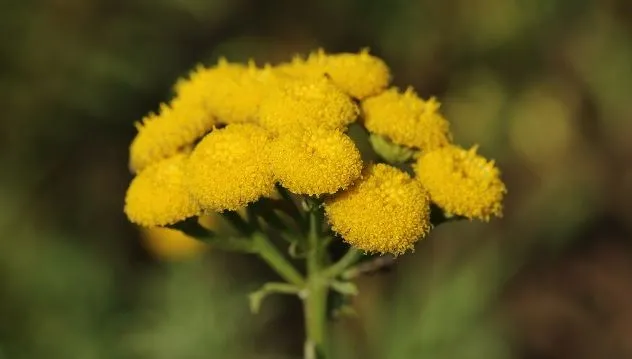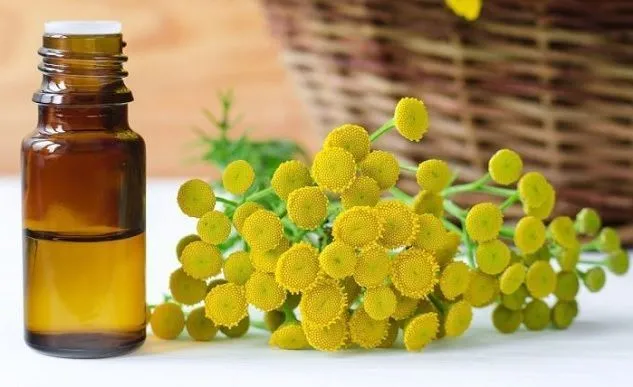In the historical list of medicinal plants, the Tansy (Tanacetum vulgare) occupies an important place. Commonly known as lombriguera herb, due to its ability to eliminate parasites and widely used by this property in antiquity, today it is in disuse due to the toxicity of some of its components.
However, it deserves its place in history and that we comment on some important characteristics of this plant, which is still used in the face of certain problems.
The name worm grass is given by the vermifuge properties of tansy, where it is currently used as a remedy to repel certain insects.
It belongs to the family of Asteraceae (Asteraceae), and is a notorious flowering herbaceous yellow, growing between 60 and 80 cm in height. Its leaves are pinnate and have a dark green color, similar to that of cypresses.
Of it, and as an introduction, it should be mentioned that they have a active substance with medicinal properties at a certain dose, and toxic if we go over concentration.

Table of Contents
History of the use of tansy as a medicinal plant
There are books and ancient writings, such as Capitulare de villis vel curtis imperii of Charlemagne, where he forces to cultivate in his lands a series of herbs and medicinal plants where the tansy is included.
At that time, the name by which the Tanacetum vulgare was that of «tanazitam“, which over the years has been derived to the word Tansy.
At the level of gardening and orchard, the tansy randomly planted is used together with vegetables, since by its components, it is an effective ally in repelling insects that feed on cultivated plants.
It emits strong aroma and repels flies and mosquitoes. This significantly limits the laying of eggs and future larvae in fruits, such as tomatoes or peppers.
In the garden it has always been a companion plant, on the one hand because it is beautiful, shaded, and is very melliferous (it attracts and feeds with its pollen many pollinators that will be beneficial to us), on the other hand and due to its strong aromas, it is a very effective repellent of flies and mosquitoes, which it disturbs and does not let the laying in the crops.
On the other hand, tansy has been used in food in Northern Europe, a typical dessert known as Easter, and very similar to the Easter cakes that are taken in Spain.
Apart from its strong flavor in contrast to cake, it also has medicinal properties that help reduce flatulence in the elongated after-dinner meals typical of the Easter period.
Common names attributed to tansy:
Vermiguera grass, earthworm grass, athanasia, anastasia, tanarid, cucera grass, tansia
Agronomic characteristics of the tansy plant
Little is known or assumed of the agronomic behavior of tansy. However, there are some references that clarify how greater productions and accumulation of the active ingredients can be obtained. At least, knowing in which areas and in which types of soil there is more presence of Tanacetum vulgare.
Tansy is known for its rusticity, growing in all kinds of places, from meadows, around trees, trails, stony sites, etc.
It is used to growing in dry environments and alkaline and even saline soils.
It does not require special humidity conditions, and the simple rainfall of the area where it spontaneously appears is sufficient. The same when it comes to providing nutrients, since it usually takes advantage of the mineralization of organic matter that the soil naturally has.
Plant multiplication
The multiplication of tansy is carried out by seeds, which are collected after flowering and preserved for sowing from March (spring).
Another simpler way is to take a stem already rooted and grow it in a pot or in its final place, since it has good capacity to root in new places. These transplants are usually done in autumn, where even the days are not very cold and there is movement of sap.
Medicinal properties of tansy

Active ingredients
- Tanacetin (alkaloid)
- Tannins
- Mucilage
- Sesquiterpenes (analgesic effect)
Medicinal properties detected
Currently there are several scientific studies and trials where the potential of Tanacetum vulgare to reduce headache and migraines.
It is attributed insect repellent, antirheumatátiacs, carminative and digestive properties, always respecting the recommended dose, since above it it is toxic.
In fact, in ancient communities tansy was used in large doses with abortive effect.
Remedy to relieve insect bites
Mix 30 drops of tansy oil diluted in 150 ml of water or alcohol. Apply and massage on the affected area.
Tansy can be combined with other medicinal plants of recognized effectiveness to scare away annoying insects, such as cantueso or thyme borriquero.
Remedy to relieve menstruation pain
Infusion of 5-10 grams of tansy flowers per liter of water. Rest and drink one cup a day during the menstruation process.
Remedy against scabies
Infusion of 20 grams of flowers and stems of tansy for each liter of water. Apply topically to the skin.
Anti-inflammatory remedy to reduce pain from blows
Mix 30 drops of tansy oil diluted in 150 ml of water or alcohol or directly massage with the fresh tansy leaves on the painful area.
Remedy with tansy to reduce pain caused by inflamed varicose veins ulcers
Mix 30 drops of tansy flowers diluted in 150 ml of oil or alcohol, massaging the affected area.
Remedy against headache and migraine
Infusion with 10-20 grams of tansy leaves. Take 1 cup a day whenever we have the pain, rested a week and repeating the intake the next.
Use of tansy as an insect repellent
Tansy currently have a great recognition as a repellent of all kinds of insects, especially flies and mosquitoes.
That is why it is usually cultivated together with horticultural plants to reduce the presence of insects that lay their eggs inside the fruits (such as the Mediterranean fly).
To prepare an effective repellent on terraces and gardens in summer, we boiled 300 grams of flowers and leaves of tansy for every 10 liters of water.
It is sprayed on plants, tables, chairs and walls in the area where we will be outside.
Contraindications
A high dose of extract from tanacetin it is toxic, and can cause abortion during pregnancy.
Likewise, it is advisable to avoid its consumption during the lactation period.
Chewing its leaves can lead to wounds, sores, and ulcers in the mouth and stomach.
Its use should be supervised by medical specialists, who evaluate contraindications with drugs and other treatments.
Curiosities about Tanacetum vulgare
The tansy has been taken as the symbol of immortality in antiquity because this plant is able to have its flower in perfect condition for almost three continuous months. Another theory says that it was considered the symbol of immortality because even once cut it has to take considerable time before it begins to wither.
Precisely because it takes a long time to wither, it was often used as a decorative flower in tombs and also this peculiarity was what led it to appear in mythological stories where this plant is used to turn Ganymede into an immortal being by the work of Zeus.

